In this guide, we will list out detailed instruction steps to install the TWRP Recovery on any Android device. To begin with, we will make you aware of the steps to recognize if your device is A partition or A/B. This will help you in understanding whether you could directly flash it to the recovery partition or rather make use of the boot partition.
Likewise, we will also share the instructions on how to boot to TWRP or permanent installation of the recovery. Talking about which, you will be able to learn the type of recovery file you would be needing (twrp.img and twrp.zip) and more importantly when they would be needed. It’s going to be a long journey ahead, so stick with us!
Table of Contents
The Need for a Custom Recovery
By default near about every OEM ships their device with a locked bootloader. They do so because they want you, the user, to only use the ecosystem that they have provided. But at the same time, they also leave a slight window open for the tech enthusiasts. Hence the interested users could make full use of this opportunity and unlock their device’s bootloader. Once you do so, you could then carry out a plentitude of tweaks on your device.
These include the likes of flashing custom ROMs, custom kernels, having access to the system partition by rooting via Magisk. Likewise, you could install ZIP and IMG files, flash mods, Magisk Modules, Substratum Themes, and the likes. However most of these tweaks to be effectively carried out, you would require a helping hand. And there is no better helping hand than a custom recovery.
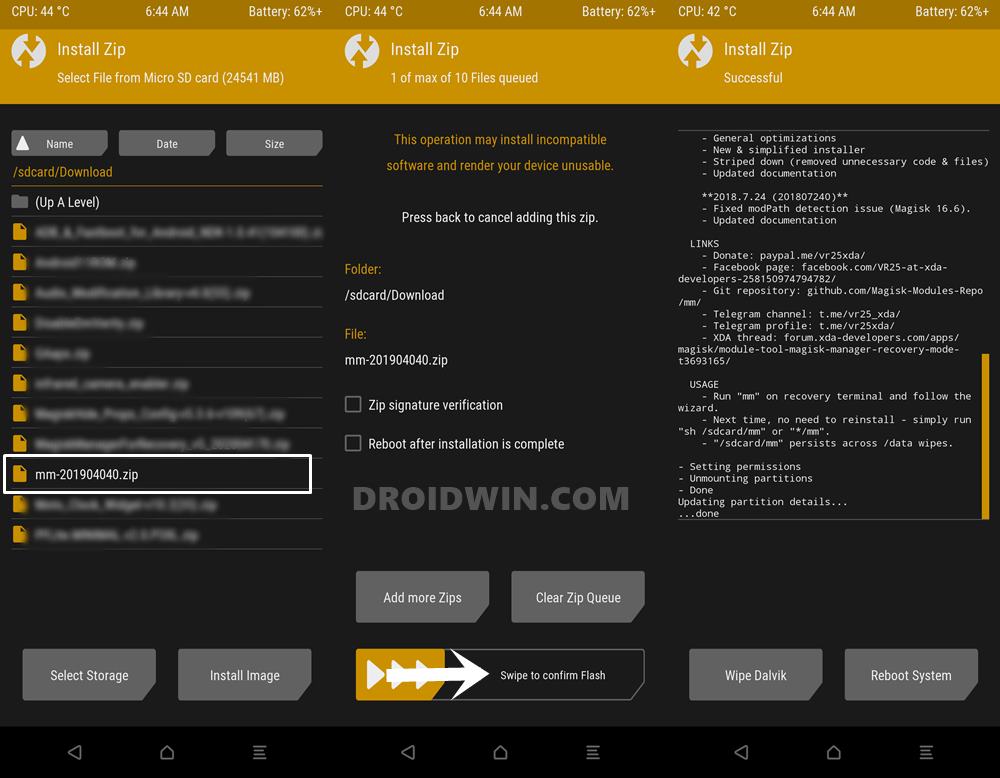
Most of the tweaks that we have mentioned above could easily be carried out via the custom build recovery itself. In earlier times, users generally flocked to the CWM recovery. While it was able to successfully execute most of the tweaks, yet it wasn’t touch-based. This meant that you had to use the hardware keys to perform any action.
To overcome this issue, the Team Win Recovery Project made its way over to the custom development, and the rest, as you would say, is history. All in all, if you have unlocked the device’s bootloader, then this should usually be your go-to custom binary. On that note, here are the required instructions to install the TWRP Recovery on any Android device. Follow along.
- How to Uninstall Magisk Modules using TWRP Recovery
- How to Fix TWRP 0MB Internal Memory Issue
- Use USB OTG or Pen Drive to Flash File via TWRP Recovery
- How to Copy Move Rename Delete Files and Folders via TWRP Recovery
How to Install TWRP Recovery on Android
We have broken down the installation steps into separate sections for ease of understanding. Proceed in the exact same sequence as mentioned. Droidwin and its members wouldn’t be held responsible in case of a thermonuclear war, your alarm doesn’t wake you up, or if anything happens to your device and data by performing the below steps.
STEP 1: Take a Backup
Installing the TWRP Recovery doesn’t usually lead to data loss. But it’s a prerequisite such as unlocking the bootloader does. Furthermore, in some instances, you might have to decrypt the data partition by performing a factory reset. All these scenarios would in turn erase the data from your device. So it is highly recommended to take a backup of all the data on your device.
STEP 2: Enable USB Debugging and OEM Unlocking
The steps to install the TWRP Recovery on Android requires you to enable USB Debugging and OEM Unlocking. [Don’t Miss: How to Enable USB Debugging on a Broken Android Devic’s Screen]. The first one is needed so that your device is able to interact with the PC in ADB Mode. This would in turn be used to boot your device to Fastboot to install the recovery.
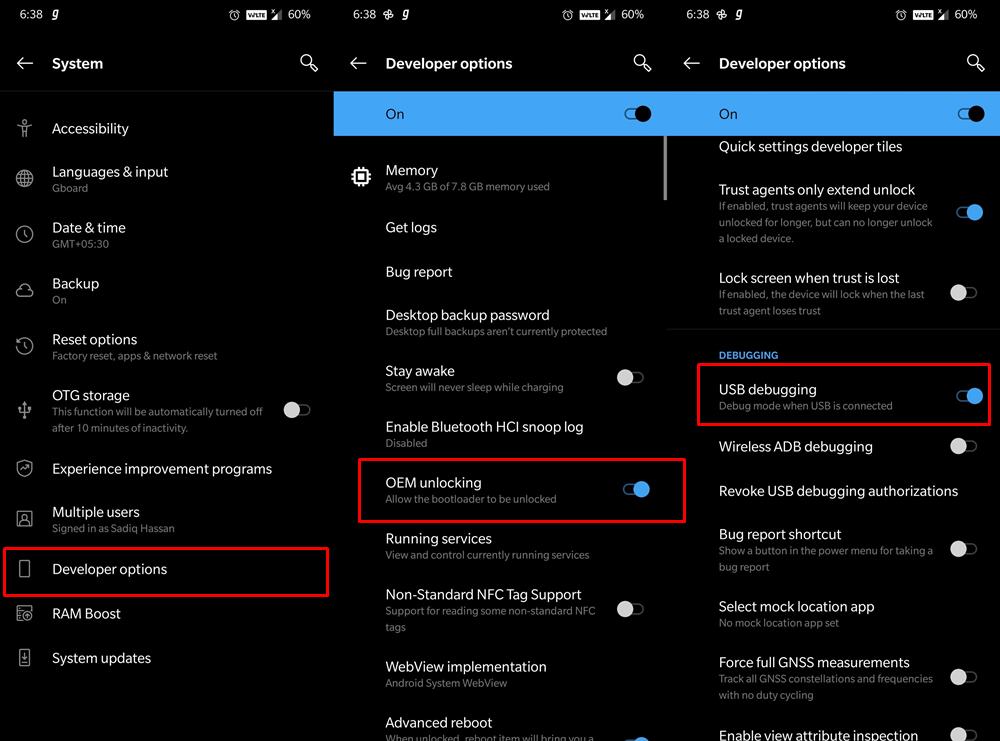
Likewise, OEM Unlocking is required to take permission for the bootloader unlocking. (If you have already unlocked the bootloader, then you don’t need to enable OEM Unlocking, rather you should only enable USB Debugging). With that said, here are the required instruction steps to enable both these options on your device:
- Head over to Settings on your device.
- Then go to the About Phone section and tap on Build Number 7 times. The developer option has now been enabled.
- After this, go back to Settings and tap on System
- Then go to Developer Options and Enable USB Debugging and OEM Unlocking.
STEP 3: Unlock Bootloader
Next up, you will also have to unlock the bootloader on your device. Until and unless you do so, you wouldn’t be able to install any custom binary, including TWRP Recovery on your Android device. But do keep in mind that the unlocking process will make the device’s warranty null and void, and would also erase all the data from your device. If that’s well and good, then refer to our device-specific guides:
- How to Unlock Bootloader on Google Pixel Devices
- How to Unlock Bootloader on any Samsung Device [New VaultKeeper Method]
- A Universal Guide to Unlock Bootloader on any Realme Device
- Steps to Unlock Bootloader on any Motorola Device
- How to Unlock the Bootloader on OnePlus
- How to Unlock Bootloader on Vivo
STEP 4: Install ADB and Fastboot on PC
You will also have to install the Android SDK Platform Tools on your PC. This is the official ADB and Fastboot binary provided by Google which helps in establishing a successful connection between your device and the PC in ADB and Fastboot modes.
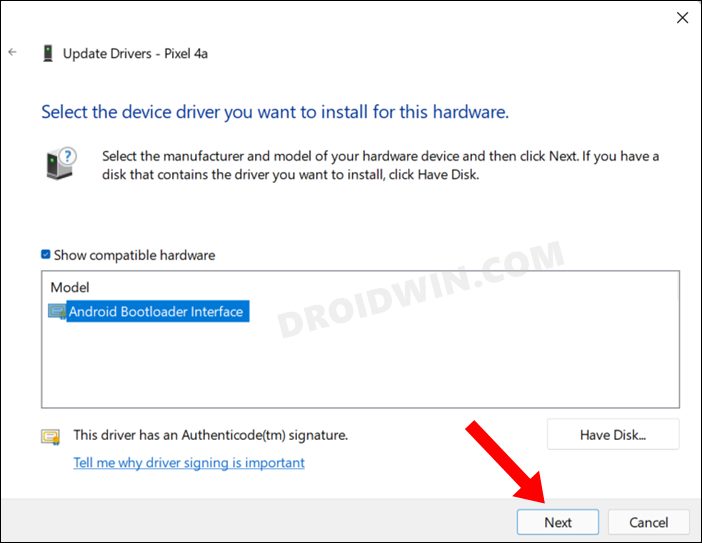
STEP 5: Download TWRP Recovery for your Android Device
Now get hold of your device’s TWRP Recovery file. The official builds have been hosted on TWRP official site. On the other hand, if your device isn’t on that list, then you may also download the unofficial builds from XDA. While some devices have both the TWRP IMG and ZIP files, others only have the TWRP IMG file. The reason for the same will be cleared later on in this guide. As of now, you simply download the available TWRP file/files for your device.
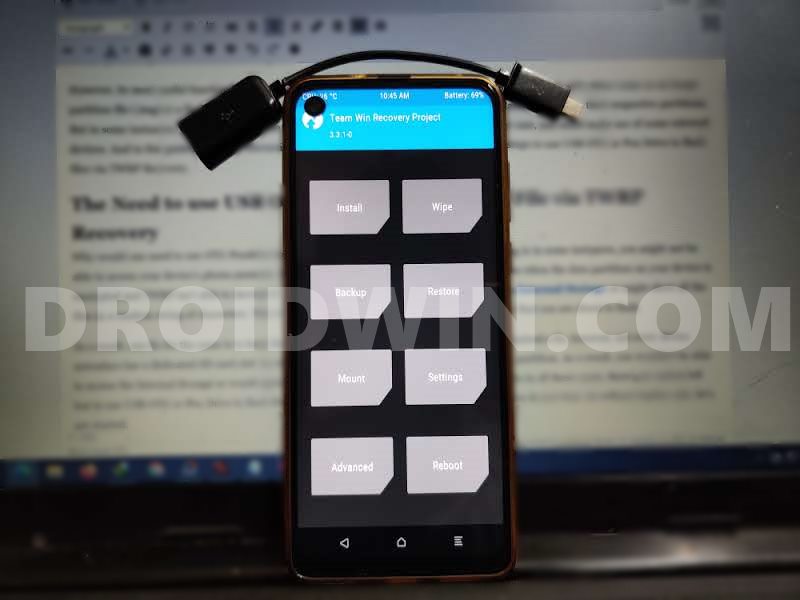
Furthermore, there is even an option of creating and porting TWRP Recovery for your Android device. While it does require technical expertise, but you may give it a try as well (if there’s no official/unofficial TWRP for your device): How to Create and Port TWRP Recovery to any Android Device. With that said, let’s proceed to the next step to install TWRP Recovery on any Android device.
STEP 6: Check if your Device has Recovery Partition
Now comes the most important part of this guide. You’ll now have to verify if your device has a recovery partition or not. If it does, then you could directly flash the TWRP Recovery to its recovery partition. However, if it doesn’t have a recovery partition, then you’ll have to take the help of the boot partition. So either refer to our detailed guide to check your device’s partition scheme or refer to the shorter instructions given below:
- First off, Download and extract the Android SDK Platform Tools folder.
- Having USB Debugging enabled, connect your device to your PC via USB.
- Launch CMD inside the platform tools and execute the below command
adb shell cd /dev/block/platform ls -la /dev/block/bootdevice/by-name
- Check if the output has recovery or recovery_a or recovery_b keywords.
- If it does, then your device has a recovery partition, otherwise, it doesn’t.
STEP 7: Check if the Device has A/B Partition or A Partition [Not Needed]
UPDATE: This step is no longer needed
If your device is A-only, then it would have the recovery partition. Hence you could directly flash the TWRP IMG file to the recovery partition. On the other hand, if it is A/B, then there wouldn’t be any recovery partition, rather it is now taken care of by the boot partition. Accordingly, the fastboot command to flash TWRP Recovery has been set up.
So it is of paramount importance to check if your device is a single partition or dual partition. So refer to the below instructions for the same. [Furthermore, I would highly suggest that you get acquainted with these A and A/B partition schemes on your device via this guide: How to Check and Change Current Active Slot on Android].
- Download and install the Treble Check app from Play Store.
- Launch it and have a look at the Seamless System Updates section.
- If the line reads as follows, then you have a dual A/B Partition (slot) device.
......and is detected to have an A/B system partition
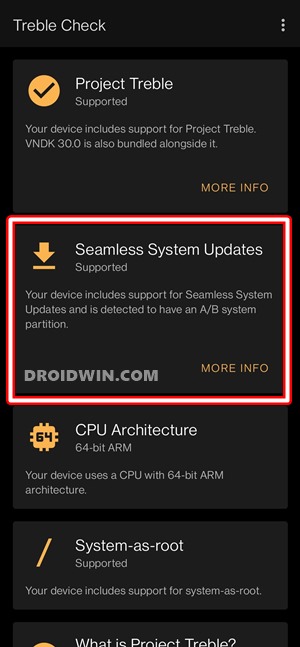
- On the other hand, if it reads out as follows, then your device has only a single partition/slot (i.e A):
....and is detected to have an A-only system partition
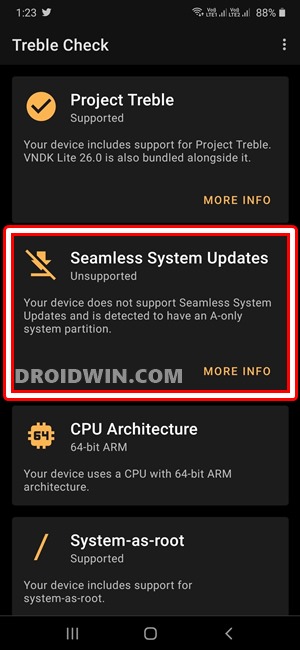
- Remember the answer as it would be used in the subsequent sections to install TWRP Recovery on your Android device.
STEP 7: Boot Device to Fastboot Mode
- It’s now time to boot your device to the Fastboot Mode. So with USB Debugging enabled, connect your device to the PC via USB cable.
- Then head over to the platform-tools folder, type in CMD in its address, and hit Enter. This should bring up the Command Prompt.

- Now execute the below command in the CMD window to boot your device to the Fastboot Mode:
adb reboot bootloader

Once done, proceed to the next step to install TWRP Recovery on your Android device. If the result from the test in STEP 6 came out to be A/B partition, then move to STEP 8B. Whereas if your device has only A partition then check out STEP 8A. if you wish to know more on this A/B vs A-only and its relation with TWRP, check out our guide on TWRP: fastboot flash vs fastboot boot: Which command to use?
STEP 8A: Install TWRP on Devices Having Recovery Partition
If your device does have a recovery partition, then you could directly flash it to that partition. Here’s how:
- To test TWRP for one-time usage, then type in the below command:
fastboot boot twrp.img

- Type in the below command to permanently install TWRP Recovery to the recovery partition
fastboot flash recovery twrp.img

- If the TWRP is booted to any other language, then refer to our guide to change TWRP language
- Next up, use the following command to boot your device to the recovery mode
fastboot reboot recovery
- Your device will now boot to TWRP and you could now carry out the desired task.
- Apart from that, you could also boot your device to TWRP and then flash TWRP to the Recovery partition itself, as shown in this guide.
STEP 8B: Install TWRP on Device without Recovery Partition
if your device does not have a recovery partition, then you’ll have to take the help of boot partition to flash TWRP on your Android device.
- Execute the below command in the CMD window to ‘boot’ your device to the TWRP Recovery
fastboot boot twrp.img

- If the TWRP is booted to any other language, then refer to our guide to change TWRP language.
- Now if you want TWRP just for one-time usage, then simply go to Reboot and select System.

- Your device will boot to the OS and TWRP will be replaced with stock recovery.
- On the other hand, if you want to permanently install TWRP, then go to its Install section.

- Then navigate to the twrp.zip file, select it, and perform a right swipe to flash it.
If your TWRP doesn’t have the ZIP file, and only comes with the IMG file, then you could either flash TWRP IMG file to the Ramdisk partition or use Flash Current TWRP.
- Once done, go to Reboot and select Recovery. Your device will reboot to TWRP.

- You may now flash the desired file. Once done, boot to the OS via Reboot > System.

- If you can’t boot to the System and stuck in a bootloop, refer to this guide: How to Fix Soft brick/Bootloop after installing TWRP Recovery.
That’s it. This was all from this guide on how to install TWRP Recovery on any Android device. If you have any queries concerning the aforementioned steps, do let us know in the comments section below. We will get back to you with a solution at the earliest. With that said, let’s turn our attention towards some of the other useful resources that might help you out.
How to Install TWRP without a ZIP File?
As I had earlier mentioned A/B devices need to have two sets of TWRP files: IMG and ZIP. However recently I came across a device (Motorola One Action), that is an A/B partition but only had the TWRP IMG file but no ZIP file. Turns out, that this wasn’t the only device and there were quite a few others belonging to this domain.
METHOD 1: Install TWRP to Ramdisk
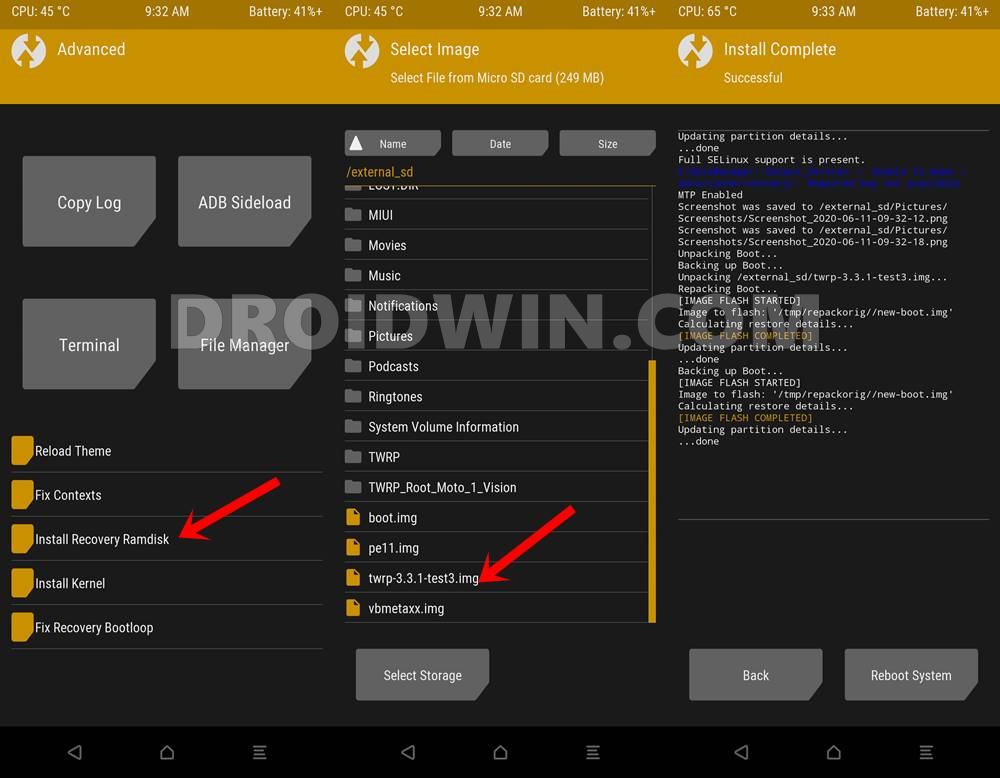
I did some research and found out that for these devices, you would have to flash the TWRP IMG to their Ramdisk as well. In other words, first off you will boot to TWRP via fastboot boot twrp.img, and then from TWRP flash the IMG file to the Ramdisk for permanent installation. If your device falls under this category as well, then please refer to this guide: How to Permanently Install TWRP without TWRP ZIP File (only using TWRP.img file).
METHOD 2: Using Flash Current TWRP
On some devices, you wouldn’t find the Install Recovery Ramdisk, rather that has now been replaced with the Flash Current TWRP option. This feature would also come in handy in case your device only has the TWRP.img file but no ZIP. For the unaware, this feature automatically picks up the twrp.img that is currently temporarily booted to your device and would then permanently flash it.
- To try it out, start by booting your device to TWRP using the below command:
fastboot boot twrp.img
- After that, go to the Advanced section and tap on Flash Current TWRP.

- The TWRP will now be permanently flashed onto your device.
- Just to be on the safer side, it is recommended to reboot your device to TWRP.

- For that, go to Reboot and select Recovery. That’s it, the process stands complete.
METHOD 3: Flash TWRP IMG from TWRP
If your device has the recovery partition, then you might not see the Install Recovery Ramdisk option. This is because you wouldn’t even need this feature in the first place. You could directly flash the TWRP to the recovery partition from the TWRP Recovery itself. Here’s how:
- First off, place the twrp.img file to the platform-tools folder on your PC and to your device’s internal storage as well.
- Then temporary boot your device to TWRP using the below command:
fastboot boot twrp.img
- After that, go to the Install section and tap on the Install Image button.
- Now select the twrp.img file and subsequently choose the Recovery partition.

- TWRP will now be permanently flashed onto your device.
- Once done, it is recommended to reboot your device to TWRP from Reboot > Recovery.

- After that, you may reboot the device to the OS via Reboot > System.
METHOD 4: Flash TWRP to Vendor_Boot Partition
How to Boot to TWRP Recovery on Android
Now that you have successfully installed TWRP Recovery on your Android device, you might occasionally need to boot to it. For that, please refer to our detailed guide on How to Boot into Recovery TWRP Recovery. If you don’t wish to check out that guide then here are the shorter instructions: use the adb reboot recovery command or the fastboot reboot recovery command. You may also use your device’s hardware key combinations.
How to Update TWRP Recovery on Android
TWRP usually gets blessed with updates that fix underlying bugs and make it more stable to use. While the frequency of updates in the official TWRP is quite low as everything has been already taken care of by the developers before releasing it officially. However, if you have downloaded an unofficial build, then you might have to occasionally update the recovery. On that note, you may refer to our comprehensive guide to Update TWRP Recovery on any Android Device.
How to Install TWRP Recovery on Samsung Devices
You cannot flash TWRP Recovery on Samsung devices by using Fastboot Commands. Rather there is a completely different set of rules to carry out this task. If you wish to know more about the same, then refer to our detailed coverage on How to Install TWRP Recovery on Samsung via Odin. If you don’t wish to check out that guide, then here are the instructions in short:
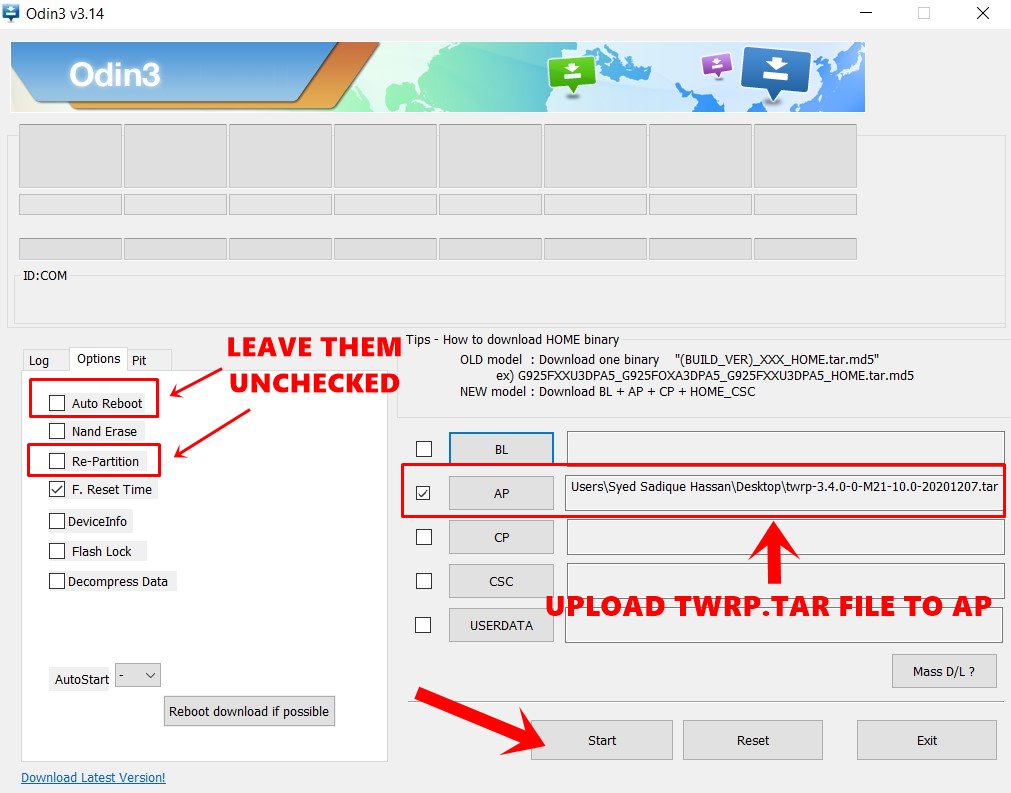
- Boot your device to Download Mode.
- Download the TWRP TAR file for your Samsung device.
- Load this TAR file in Odin’s AP slot and click Start.
How to Remove/Uninstall TWRP from my Device?
If you no longer require TWRP Recovery and wish to revert to stock, then this guide shall help you out: How to Uninstall TWRP and Restore Stock Recovery on Android.
On that note, we conclude this tutorial on how to install TWRP Recovery on any Android device. We have tried to cover all the important aspects of this custom recovery. However, if you feel we missed any, do share your views with us in the comments section below.
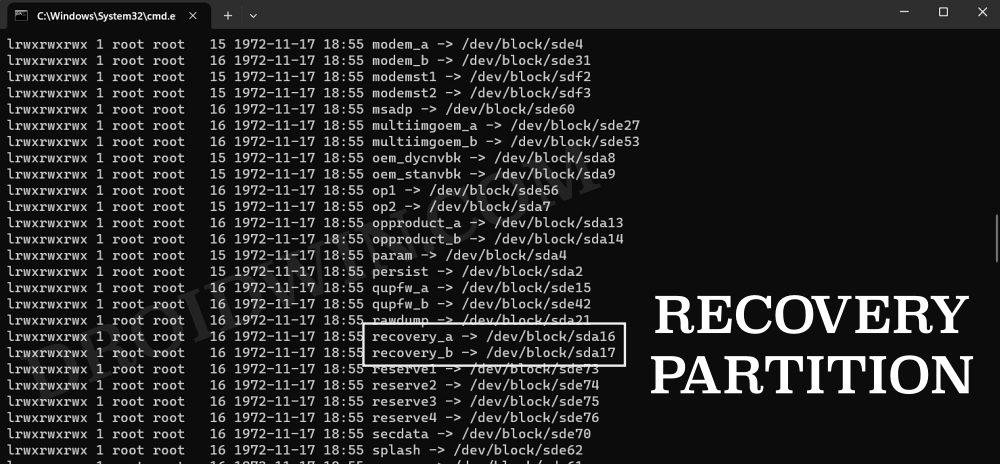

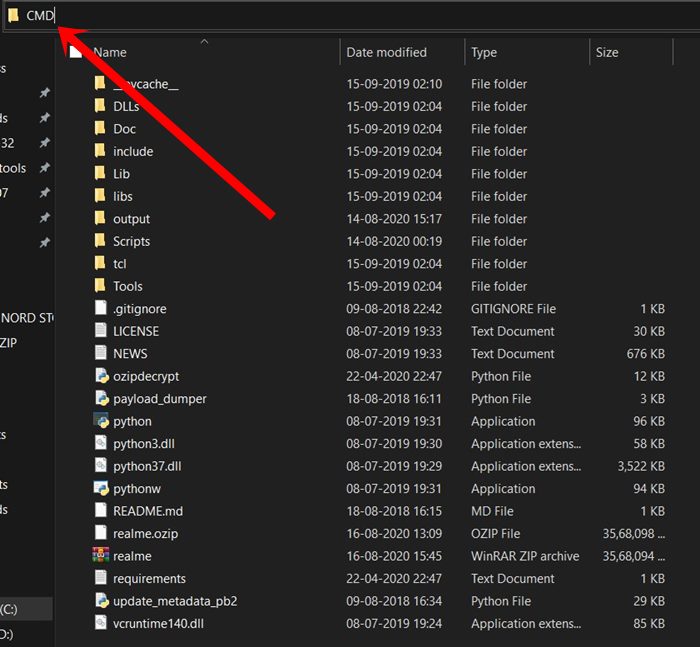
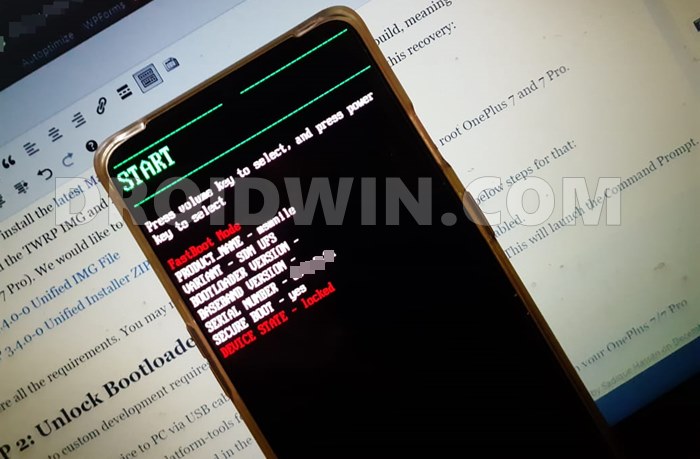



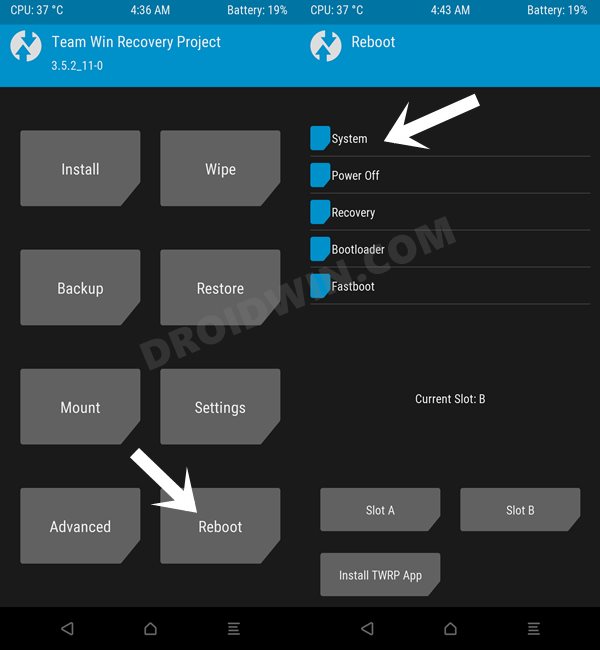
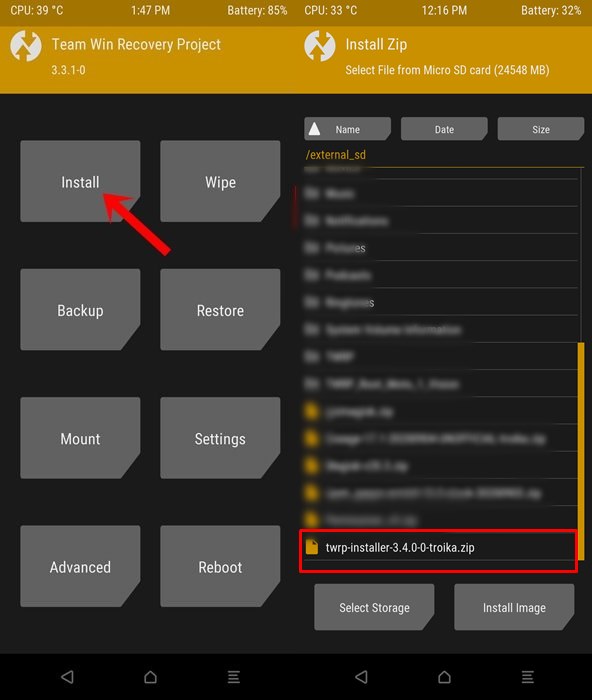
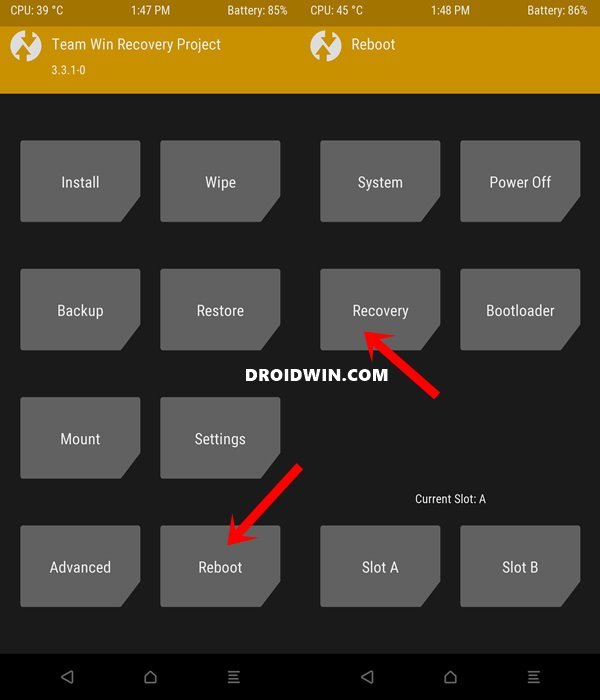

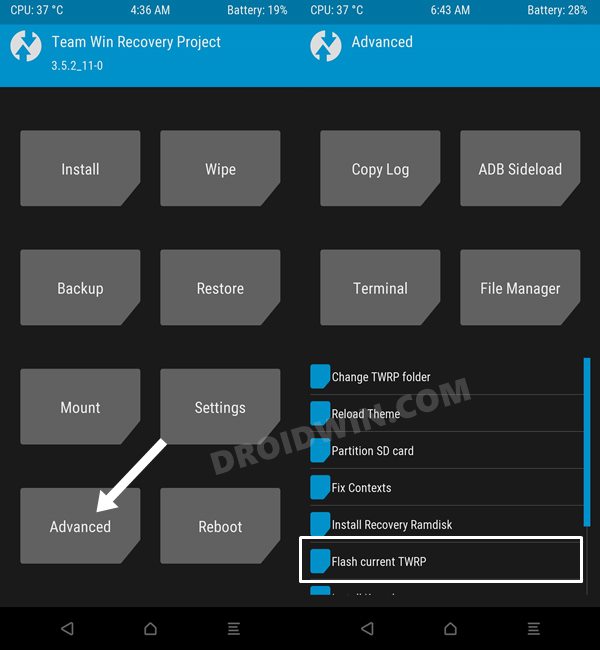
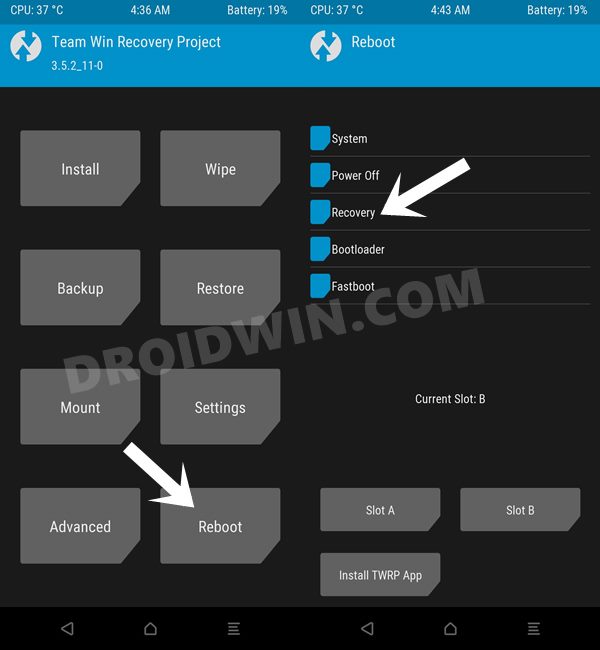
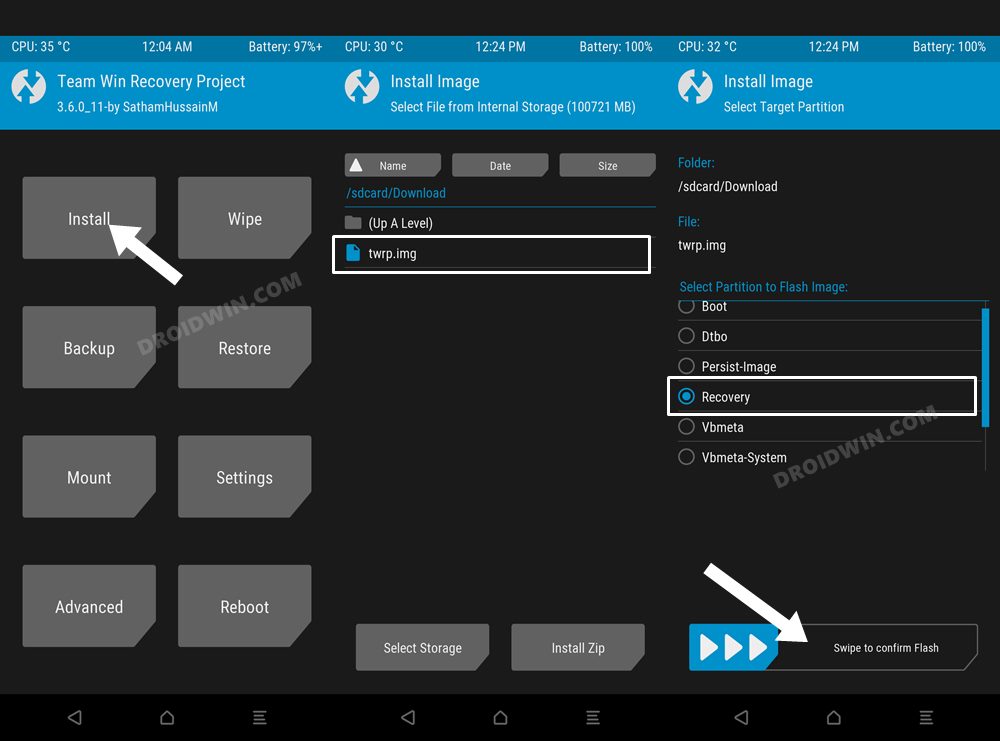
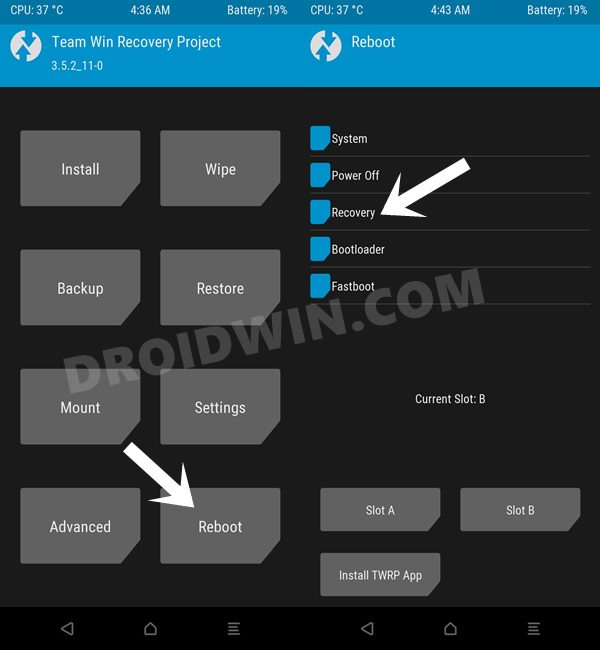
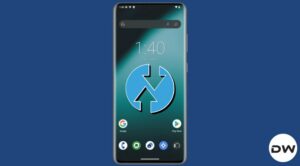



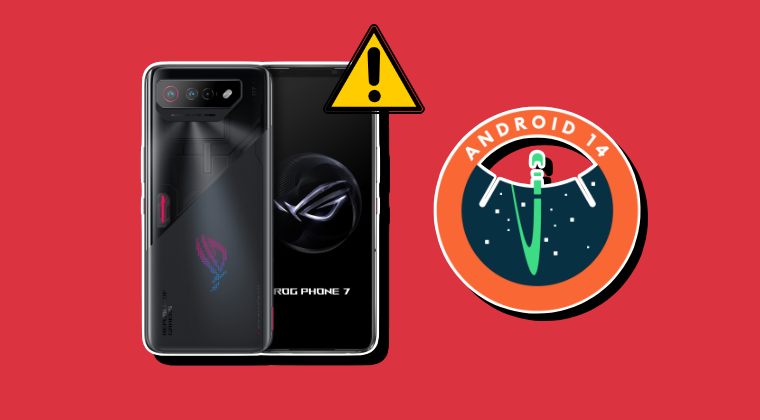
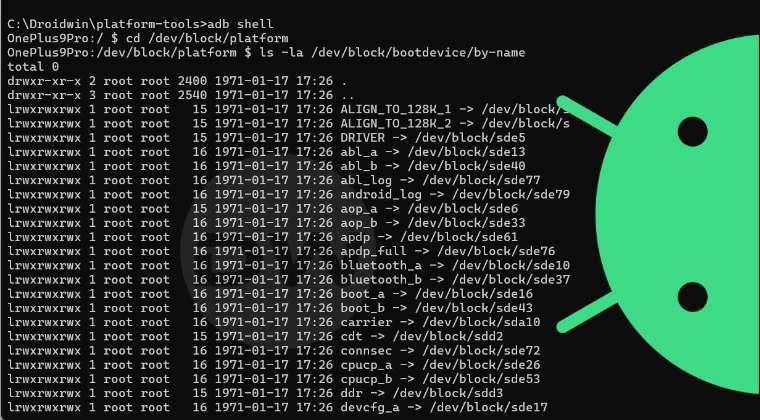
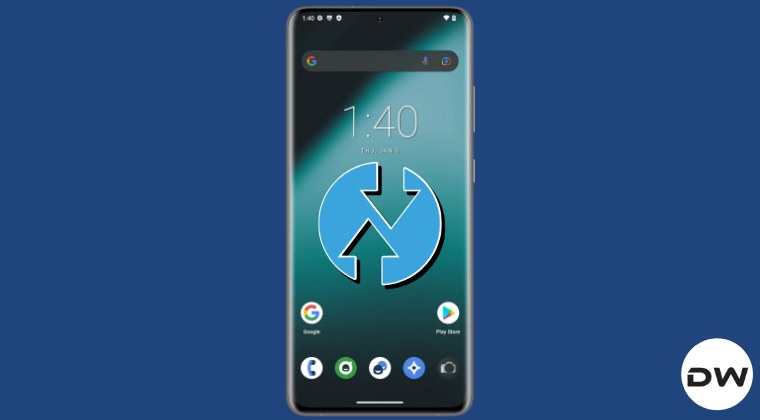
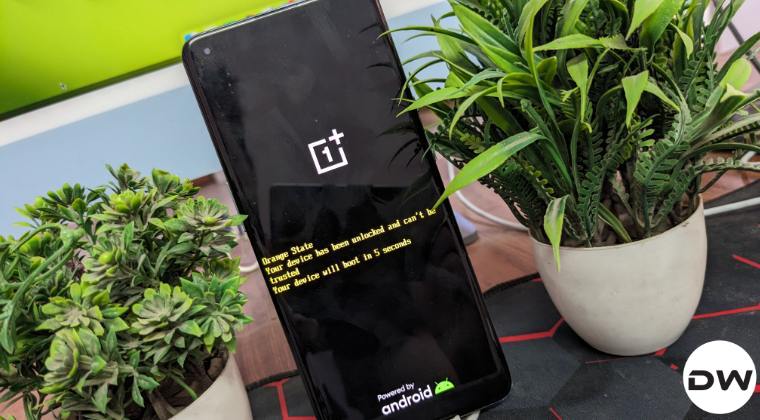
Spacemonkey
Hello SADIQUE HASSAN,
I have a Pixel 7(panther) running Android 14 with the a/b partition. I followed your steps a few times trying to get TWRP(3.7.0-9-Sailfish) installed , but get 2 different errors.
Error 1: FAILED (Write to device failed in SendBuffer() (no link)) or
Error 2: FAILED (remote: ‘failed to download image’)
Both of the errors come from these commands:
fastboot boot twrp.img or fastboot flash boot twrp.img
I have also tried using: boot_a, boot_b, boot_ab, & boot_ba. I used Magisk 26.4 to root the P7 & had to root “slot b” first then “slot a”. I also tried install twrp in the same manner, but to no avail. Please Help.
Tung
Dear SADIQUE HASSAN,
Why “STEP 7: Check if the Device has A/B Partition or A Partition [Not Needed]”?
Tung
Dear SADIQUE HASSAN,
Why is step 7 not needed anymore?
Looking forward to receiving your response
yehuda
hello SADIQUE HASSAN,
my phone is oneplus nord ce 5g ,android 12 ,version EB2103.
i didn’t found TWRP for this version ,my question is , can i use other TWRP build for oneplus nord ce 5g , for ex :twrp-3.5.2_11-ebba.img ?
thank you
Benjamin
Hello Sadique Sir,
I need your help, i have a Huawei android device (huawei honor 10) ith sensitive document inside and i have lost the password. Please how can i get to recover this device without wiping out the data ? Its looking almost impossible, everyone i have met with plan will result to data loss and phone memory wipe.
Parduz
Hello, i’ve got a Samsung Tab2 10″ (P7500): the Tab already has TWRP 3.1.1 in it but NO OS, so it boots just on recovery or on download mode.
I’m trying to update TWRP to 3.3.0-2 to install a new ROM (’cause it fails with this version of TWRP) but the update always fails:
no matter if i use ODIN3 or TWRP Flash image -> recovery, the error is the same: the image size is bigger than the partition (which seems to be 2048).
What should i do?
محمد
My device will boot the file with the command fastboot boot twrp.img Completes and then reboots automatically but does not enter the recovery environment and goes back to the Android environment? How to solve this problem
my device redmi note 10 s, bootloader is unlock and android 11 global whit miui 12.5 in my device
Sadique Hassan
Does the booted TWRP have the Install Recovery Ramdisk option under Advanced? If yes, then flash the twrp.img file using that method for permanent installation- as explained in POINT 7 Method 1 of this guide. Or use the Flash Current TWRP option under Advanced [POINT 7 Method 2]. Or if your device has a TWRP ZIP file, then consider flashing it via TWRP [after booting it via twrp.img file]
محمد
My device will boot the file with the command fastboot boot twrp.img Completes and then reboots automatically but does not enter the recovery environment and goes back to the Android environment? How to solve this problem
my device redmi note 10 s, bootloader is unlock and android 11 global whit miui 12.5 in my device
gie
1. In A/B devices, which partition does the TWRP installed to?
2. Does this cmd: `fastboot flash boot twrp.img` will erase the whole boot partition?
3. what is ramdisk, where it is?
D Raju
Hi ,
I am using One Plus6 . Suddenly it is showing a message that Qualcum CrashDump Mode on black screen. Service center executive told me to replace the motherboard with new one, but not given assurance for data in side the dead mobile.
For Qualcum Crash Dump Mode problem, is there any chance to recover the Data.
Please guide me me bro.
Sadique Hassan
Hi D Raju, if you haven’t corrupted the system partition, then you could easily bypass the Qualcomm CrashDump Mode just by using hardware key combinations: How to Exit Qualcomm Crash Dump Mode in OnePlus Devices However, if the partition is corrupted, then you would have to use the MSM Download Tool, which will unfortunately wipe all the data from your device.